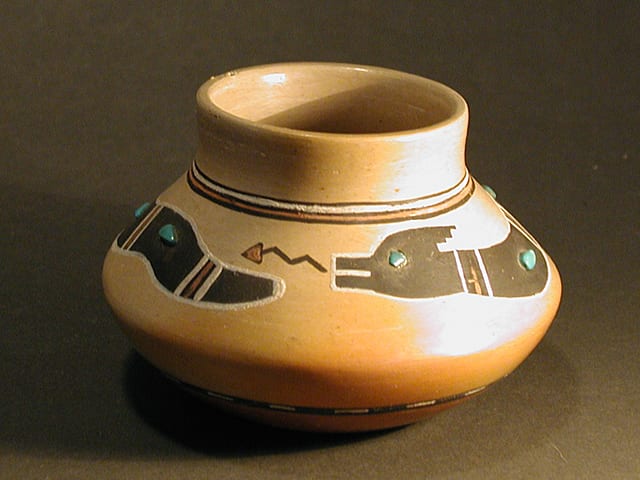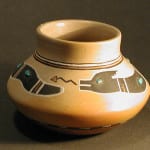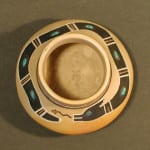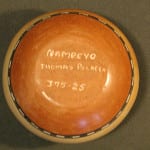Two delicate bands of paint, one white and one tan-red framed with black lines, encircle the neck of this pot. The bottom of the pot is painted tan-red and is separated from the rest of the pot with a band of black with white rectangles. The outdoor dung-firing and blushed clay are Hopi-Tewa, but the Awanyu figure and attached turquoise are based in the recent pottery tradition of Santa Clara pueblo, 250 miles east of Hopi.
The rim has two small chips that have been knocked off and reattached. The bottom is inscribed with three lines of writing: Nampeyo/Thomas Polacca/J75-25. The pot was sold by Bruce McGee of McGee’s Trading post (Keams Canyon) to Eldon Brown. Bruce says that the third line should be interpreted as “July 1975, the 25th pot made that month.” [For another Thomas Polacca pot made with turquoise the next month, see an 11/07 eBay auction description, on file.]
Thomas (1935-2003) was the son of Fannie and began making pottery in the early 1970s when he was already in his late 30s. (At the time, Hopi-Tewa men did not make pottery.) It was not until 1972 that Thomas began decorating pottery; this pot was made three years later. (Blairs, 1999:228.)
Unlike his mother, Thomas did not want to produce pots with traditional “Nampeyo” designs; this pot is an early experiment in innovation. The style seems to have been inspired by the work of Joseph Loanwolf of Santa Clara. No other Hopi potter of his generation used turquoise in his decoration; even for Thomas the use of turquoise is unusual. A 1978 pot with inlaid turquoise, but an incised design, is pictured in the Blair book (1999:Fig 4.45, p. XXIX). Later, Thomas developed a method of producing thick-wall pots that were deep carved to show scenes of Hopi ritual life.
Like his mother in the 1930s, Thomas at first signed his pots with the name “Nampeyo” followed by his name. Apparently, early in their careers both mother and son advertised their Nampeyo roots to attract buyers. Later, when collectors knew them, Fannie used her name first and Thomas (in 1988) dropped the Nampeyo reference. (See Blairs, 1999:153-154 and 229.) Since the late 1960s, Loanwolf has marked every pot he has made with inventory number and for a time in the 1970s a few Hopi-Tewa potters (including Tom Polacca) took up the practice. Hopi potters discontinued the practice a few years later.
Tom’s deep-carved style became his hallmark and the style is used by a number of his children and younger relatives. In the early 1990s, I was present at a kachina dance on First Mesa where more than a dozen koshari clowns dressed up as Tom Polacca and demonstrated pottery making—apparently a jocular reference to Tom’s practice of hiring others to do much of his pottery work and then finishing the pot and signing his name. While I don’t particularly respond to this new carved style, the technique does seem to combine the traditional crafts of potting and kachina carving.




